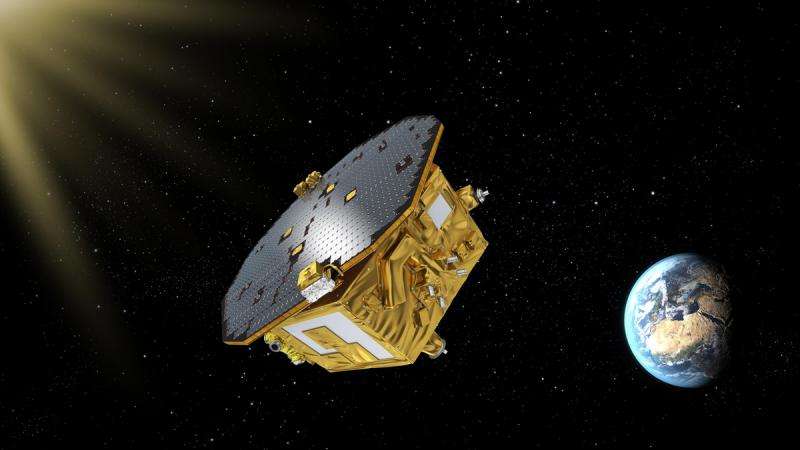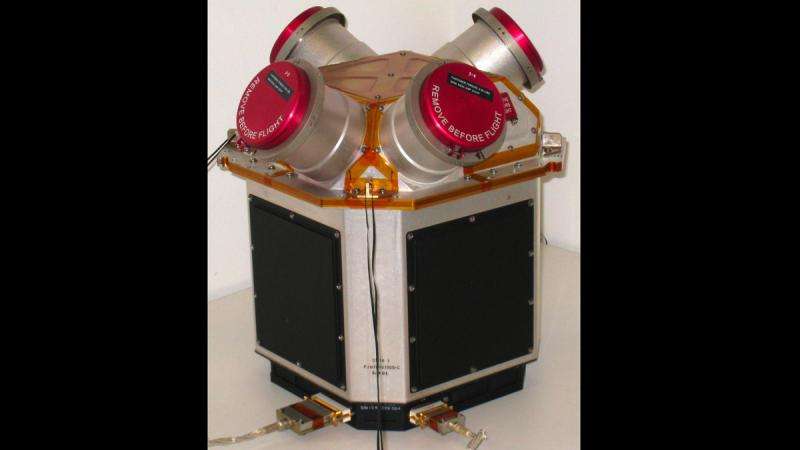NASA microthrusters achieve success on ESA's LISA pathfinder

A next-generation technology demonstration mission has just passed a big milestone.
The Space Technology 7 Disturbance Reduction System (ST7-DRS) is a system of thrusters, advanced avionics and software managed by NASA's Jet Propulsion Laboratory, Pasadena, California. It has been flying on the European Space Agency's LISA Pathfinder spacecraft, which launched from Kourou, French Guiana on Dec. 3, 2015 GMT (Dec. 2 PST). As of Oct. 17, the system had logged roughly 1,400 hours of in-flight operations and met 100 percent of its mission goals.
Most thrusters are designed to move a spacecraft, but ST7-DRS has a different purpose: to hold Pathfinder as perfectly still as possible. This allows the spacecraft to test technologies used in the detection of gravitational waves, whose effects are so miniscule that it requires extreme steadiness to detect them.
Just how steady is that? Steady enough that "position noise"—subtle vibrations in Pathfinder's position—won't exceed 2 nanometers. That's about the diameter of a DNA helix. This kind of precision is needed to counteract the biggest disturbance to Pathfinder: the pressure from sunlight pushing on the spacecraft (about 25 micronewtons).
"Here's another way of thinking about it: when the thrusters fire at full throttle, they produce a maximum force of 30 micronewtons—equivalent to the weight of a mosquito landing on the spacecraft," said John Ziemer of JPL, ST7-DRS systems lead. "To maintain our precise position, the thrusters can be controlled in 0.1 micronewton increments, equivalent to the weight of that mosquito's antenna."

Balancing all the disturbances on the spacecraft allows Pathfinder's instruments to stay in near-perfect free fall. This lays the groundwork for a future Pathfinder-type mission, which will need this kind of stability to cancel out any force other than the subtle tug of gravitational waves, produced by supermassive objects like black holes.
"This achievement represents the last hurdle for this microthruster technology development, which the project has been chartered to perform," said JPL's Phil Barela, project manager for ST7-DRS. "Our successful development and demonstration of this electrospray technology will pave the way for future gravitational wave missions, or other missions requiring precise control of spacecraft position and pointing."
Large space observatories and spacecraft formation-flying missions could both benefit from this technology, Barela added.
ST7-DRS is a system of eight thrusters positioned on either side of the Pathfinder spacecraft. Each thruster emits microscopic liquid droplets called a colloid electrospray, which are created and charged through an electric field. These ionized droplets are accelerated by a second electric field with an opposite charge, which pushes them out of the thruster. The force of that reaction provides the "thrust" that steadies the spacecraft.
The electrospray microthrusters were developed by Busek Co., Inc., Natick, Massachusetts, with technical support from JPL.
"The success of the ST7-DRS mission emphasizes the enormous benefit of one of NASA/JPL's key charters: to mature high-risk technology that can benefit future space exploration," Barela said. "The collaborative relationship between NASA/JPL, ESA, Busek and Goddard Space Flight Center has been the key enabler for this project's success."
Provided by NASA




















